Fuzzy Evaluation of Inland Ship Lock Service Condition Based on Combination Weighting and Matter-Element Extension Cloud Model
Abstract
1. Introduction
2. Materials and Methods
2.1. Analysis of the Service Status Evaluation Factors
2.2. Service Condition Level Gradation
2.3. Quantification and Gradation of Indicators
2.4. Weight Assignment of Indicators
2.4.1. Subjective Weight by Order Relation Method
2.4.2. Objective Weight by Entropy Weight Method
2.4.3. Objective Weight by Entropy Weight Method
2.5. Construction of an Extension Cloud Evaluation Model
2.5.1. Cloud Model of Evaluation Factors
2.5.2. Correlation Calculation
2.5.3. Evaluation Results
3. Results
4. Discussion
5. Conclusions
Author Contributions
Funding
Institutional Review Board Statement
Informed Consent Statement
Data Availability Statement
Conflicts of Interest
References
- Farazi, N.P.; Zou, B.; Sriraj, P.S.; Dirks, L.; Lewis, E.; Manzanarez, J.P. State-level performance measures and database development for inland waterway freight transportation: A US context and a case study. Res. Transp. Bus. Manag. 2022, 45, 100866. [Google Scholar] [CrossRef]
- Oztanriseven, F.; Nachtmann, H.; Moradpour, S. Economic Impact of Investment Scenarios in the McClellan-Kerr Arkansas River Navigation System. J. Mar. Sci. Eng. 2022, 10, 923. [Google Scholar] [CrossRef]
- Carstensen, N.; Jappelt, U.; Willems, H. Overhaul of solid construction locks in German federal waterways. Proc. Inst. Civ. Eng.-Eng. Hist. Herit. 2020, 173, 26–34. [Google Scholar] [CrossRef]
- Madson, K.; Lather, J. A Framework for Evaluating Societal Impacts Caused by Disruptions to Inland Waterways. In Proceedings of the Construction Research Congress (CRC) on Project Management and Delivery, Contracts, and Design and Materials, Via Dept Civil & Environm Engn, Vecellio Construct Engn & Management Progr, Arlington, Virginia, 9–12 March 2022; pp. 38–47. [Google Scholar] [CrossRef]
- Lyu, M.N.; Zhu, X.Q.; Yang, Q.S. Condition assessment of heritage timber buildings in operational environments. J. Civ. Struct. Health Monit. 2017, 7, 505–516. [Google Scholar] [CrossRef]
- El Mekkaoui, S.; Benabbou, L.; Caron, S.; Berrado, A. Deep Learning-Based Ship Speed Prediction for Intelligent Maritime Traffic Management. J. Mar. Sci. Eng. 2023, 11, 191. [Google Scholar] [CrossRef]
- Carral, L.; Tarrío-Saavedra, J.; Álvarez-Feal, J.-C.; Naya, S.; Sabonge, R. Modeling and forecasting of Neopanamax vessel transit time for traffic management in the Panama Canal. J. Mar. Sci. Technol. 2020, 25, 379–396. [Google Scholar] [CrossRef]
- Liao, P. Improved Analytical Model for Estimating the Capacity of a Waterway Lock. J. Waterw. Port Coast. Ocean Eng. 2018, 144, 04018021. [Google Scholar] [CrossRef]
- Geyer, S.; Papaioannou, I.; Kunz, C.; Straub, D. Reliability assessment of large hydraulic structures with spatially distributed measurements. Struct. Infrastruct. Eng. 2020, 16, 599–612. [Google Scholar] [CrossRef]
- Kunz, C. Robustness as a decision criterion for construction and evaluation of ship lock chambers. In Proceedings of the 6th International Symposium on Life-Cycle Civil Engineering (IALCCE), Ghent, Belgium, 18–31 October 2018; pp. 727–732. [Google Scholar]
- Pitacco, I.; Pauletta, M.; Somma, G.; Russo, G. On the design of the gate seals of the new Panama canal locks. Eng. Struct. 2021, 235, 111997. [Google Scholar] [CrossRef]
- Farinha, A.; Sousa, L.; Reis, L. Evaluating lock gates’ strength due to ship collisions: A Douro waterway lock gates case study. Mar. Struct. 2018, 60, 261–278. [Google Scholar] [CrossRef]
- Eick, B.; Fillmore, T.B.; Smith, M.D.; Alexander, Q.; Spencer, B.F. Detection of uneven hoisting of a Tainter lock gate: A case study for The Dalles Lock and Dam. J. Civ. Struct. Health Monit. 2020, 10, 557–571. [Google Scholar] [CrossRef]
- Lozano, C.; Langston, M.; Kashefizadeh, M.H.; Prinz, G.S. Analytical and Experimental Investigation into Pre-Stressed Carbon Fiber Reinforced Polymer (CFRP) Fatigue Retrofits for Steel Waterway Lock-Gate Structures. Metals 2022, 12, 88. [Google Scholar] [CrossRef]
- Chadha, M.; Ramancha, M.K.; Vega, M.A.; Conte, J.P.; Todd, M.D. The modeling of risk perception in the use of structural health monitoring information for optimal maintenance decisions. Reliab. Eng. Syst. Saf. 2023, 229, 108845. [Google Scholar] [CrossRef]
- Golak, J.A.P.; Defryn, C.; Grigoriev, A. Optimizing fuel consumption on inland waterway networks: Local search heuristic for lock scheduling. Omega-Int. J. Manag. Sci. 2022, 109, 102580. [Google Scholar] [CrossRef]
- Hammedi, W.; Senouci, S.M.; Brunet, P.; Ramirez-Martinez, M. Two-Level Optimization to Reduce Waiting Time at Locks in Inland Waterway Transportation. ACM Trans. Intell. Syst. Technol. 2022, 13, 1–30. [Google Scholar] [CrossRef]
- Ji, B.; Zhang, D.Z.; Yu, S.S.; Kang, C.A.X. Mathematical programming models for scheduling multiple cascaded waterway locks. Comput. Ind. Eng. 2021, 156, 107289. [Google Scholar] [CrossRef]
- Deng, Y.; Sheng, D.; Liu, B. Managing ship lock congestion in an inland waterway: A bottleneck model with a service time window. Transp. Policy 2021, 112, 142–161. [Google Scholar] [CrossRef]
- Huang, S.; Chang, J.; Leng, G.; Huang, Q. Integrated index for drought assessment based on variable fuzzy set theory: A case study in the Yellow River basin, China. J. Hydrol. 2015, 527, 608–618. [Google Scholar] [CrossRef]
- Shi, S.; Zhang, D.; Su, Y.; Wan, C.; Zhang, M.; Liu, C. A Fuzzy-Based Decision-Making Model for Improving the Carrying Capacity of Ship Locks: A Three Gorges Dam Case. J. Mar. Sci. Eng. 2019, 7, 244. [Google Scholar] [CrossRef]
- Zhang, P.; Feng, G. Application of fuzzy comprehensive evaluation to evaluate the effect of water flooding development. J. Pet. Explor. Prod. Technol. 2018, 8, 1455–1463. [Google Scholar] [CrossRef]
- Guo, F.; Xu, W.Y.; Xu, F. Optimized Based on Cloud Model Extension Assessment of Slope Stability. Adv. Mater. Res. 2011, 163–167, 2709–2714. [Google Scholar] [CrossRef]
- Cao, Y.; Bian, Y. Improving the ecological environmental performance to achieve carbon neutrality: The application of DPSIR-Improved matter-element extension cloud model. J. Environ. Manag. 2021, 293, 112887. [Google Scholar] [CrossRef] [PubMed]
- Dong, J.; Wang, D.; Liu, D.; Ainiwaer, P.; Nie, L. Operation Health Assessment of Power Market Based on Improved Matter-Element Extension Cloud Model. Sustainability 2019, 11, 5470. [Google Scholar] [CrossRef]
- Zhu, X.; Bao, T.; Yeoh, J.K.W.; Jia, N.; Li, H. Enhancing dam safety evaluation using dam digital twins. Struct. Infrastruct. Eng. 2021, 19, 904–920. [Google Scholar] [CrossRef]
- Wu, J.J.; Hu, S.P.; Jin, Y.X.; Fei, J.G.; Fu, S.S. Performance Simulation of the Transportation Process Risk of Bauxite Carriers Based on the Markov Chain and Cloud Model. J. Mar. Sci. Eng. 2019, 7, 108. [Google Scholar] [CrossRef]
- Jeong, J.; Jeong, J. Novel approach of the integrated work & risk breakdown structure for identifying the hierarchy of fatal incident in construction industry. J. Build. Eng. 2021, 41, 102406. [Google Scholar] [CrossRef]
- Cheng, Y.; Cheng, H. Concept and application of engineering breakdown structure. China Civ. Enginee Ring J. 2014, 47, 125–130. (In Chinese) [Google Scholar] [CrossRef]
- Zhang, N.N.; Guo, M.T.; Xu, S.D.; Mao, L.Y.; Chen, X.T.; Liu, C.Y. Research on the evaluation index system of inland waterway lock service status. J. Waterw. Habor 2022, 4, 477–483. (In Chinese) [Google Scholar]
- Zhang, L.; Skibniewski, M.J.; Wu, X.; Chen, Y.; Deng, Q. A probabilistic approach for safety risk analysis in metro construction. Saf. Sci. 2014, 63, 8–17. [Google Scholar] [CrossRef]
- Zhang, L.; Wu, X.; Chen, Q.; Skibniewski, M.J.; Hsu, S.-C. Towards a safety management approach for adjacent buildings in tunneling environments: Case study in China. Build. Environ. 2014, 75, 222–235. [Google Scholar] [CrossRef]
- Wang, J.D.; Pang, W.J.; Wang, L.P.; Pang, X.P.; Yokoyama, R. Synthetic Evaluation of Steady-state Power Quality Based on Combination Weighting and Principal Component Projection Method. Csee J. Power Energy Syst. 2017, 3, 160–166. [Google Scholar] [CrossRef]
- Wang, M.; Wang, X.; Liu, Q.; Shen, F.; Jin, J. A novel multi-dimensional cloud model coupled with connection numbers theory for evaluation of slope stability. Appl. Math. Model. 2020, 77, 426–438. [Google Scholar] [CrossRef]
- Wu, Y.; Tao, Y.; Deng, Z.; Zhou, J.; Xu, C.; Zhang, B. A fuzzy analysis framework for waste incineration power plant comprehensive benefit evaluation from refuse classification perspective. J. Clean. Prod. 2020, 258, 120734. [Google Scholar] [CrossRef]
- Ma, S.; Lyu, S.; Zhang, Y. Weighted clustering-based risk assessment on urban rainstorm and flood disaster. Urban Clim. 2021, 39, 100974. [Google Scholar] [CrossRef]
- Wang, X.T.; Li, S.C.; Xu, Z.H.; Hu, J.; Pan, D.D.; Xue, Y.G. Risk assessment of water inrush in karst tunnels excavation based on normal cloud model. Bull. Eng. Geol. Environ. 2019, 78, 3783–3798. [Google Scholar] [CrossRef]
- Guo, M.; Gao, C.; Yang, X.; Jiang, C.; Zhao, J.; Hu, W. Evaluation Technology Research for Lock Chamber Walls Based on the Fuzzy Comprehensive Evaluation Model. J. Jiangnan Univ. Nat. Sci. Ed. 2014, 13, 720–725. (In Chinese) [Google Scholar] [CrossRef]
- Losiewicz, Z.; Mironiuk, W.; Cioch, W.; Sendek-Matysiak, E.; Homik, W. Application of Generator-Electric Motor System for Emergency Propulsion of a Vessel in the Event of Loss of the Full Serviceability of the Diesel Main Engine. Energies 2022, 15, 2833. [Google Scholar] [CrossRef]
- Li, J.Y.; Xu, J.M.; Tan, X. Dynamic Comprehensive Benefit Evaluation of the Transnational Power Grid Interconnection Project Based on Combination Weighting and TOPSIS Grey Projection Method. Sustainability 2018, 10, 4672. [Google Scholar] [CrossRef]
- Wang, W.; Li, H.; Hou, X.; Zhang, Q.; Tian, S. Multi-Criteria Evaluation of Distributed Energy System Based on Order Relation-Anti-Entropy Weight Method. Energies 2021, 14, 246. [Google Scholar] [CrossRef]
- Wang, Y.K.; Sheng, D.; Wang, D.; Ma, H.Q.; Wu, J.C.; Xu, F. Variable Fuzzy Set Theory to Assess Water Quality of the Meiliang Bay in Taihu Lake Basin. Water Resour. Manag. 2014, 28, 867–880. [Google Scholar] [CrossRef]
- Waseem, M.; Ajmal, M.; Kim, T.W. Development of a new composite drought index for multivariate drought assessment. J. Hydrol. 2015, 527, 30–37. [Google Scholar] [CrossRef]
- Zhang, N.; Gao, J.; Xu, S.; Tang, S.; Guo, M. Establishing an evaluation index system of Coastal Port shoreline resources utilization by objective indicators. Ocean Coast. Manag. 2022, 217, 106003. [Google Scholar] [CrossRef]
- Zhang, L.; Wu, X.; Ding, L.; Skibniewski, M.J. A novel model for risk assessment of adjacent buildings in tunneling environments. Build. Environ. 2013, 65, 185–194. [Google Scholar] [CrossRef]
- Guo, Q.; Amin, S.; Hao, Q.; Haas, O. Resilience assessment of safety system at subway construction sites applying analytic network process and extension cloud models. Reliab. Eng. Syst. Saf. 2020, 201, 106956. [Google Scholar] [CrossRef]
- Wu, Y.; Yang, M.; Zhang, H.; Chen, K.; Wang, Y. Optimal Site Selection of Electric Vehicle Charging Stations Based on a Cloud Model and the PROMETHEE Method. Energies 2016, 9, 157. [Google Scholar] [CrossRef]
- Zou, Y.Y.; Zhang, Y.J.; Ma, Z.H. Emergency Situation Safety Evaluation of Marine Ship Collision Accident Based on Extension Cloud Model. J. Mar. Sci. Eng. 2021, 9, 1370. [Google Scholar] [CrossRef]
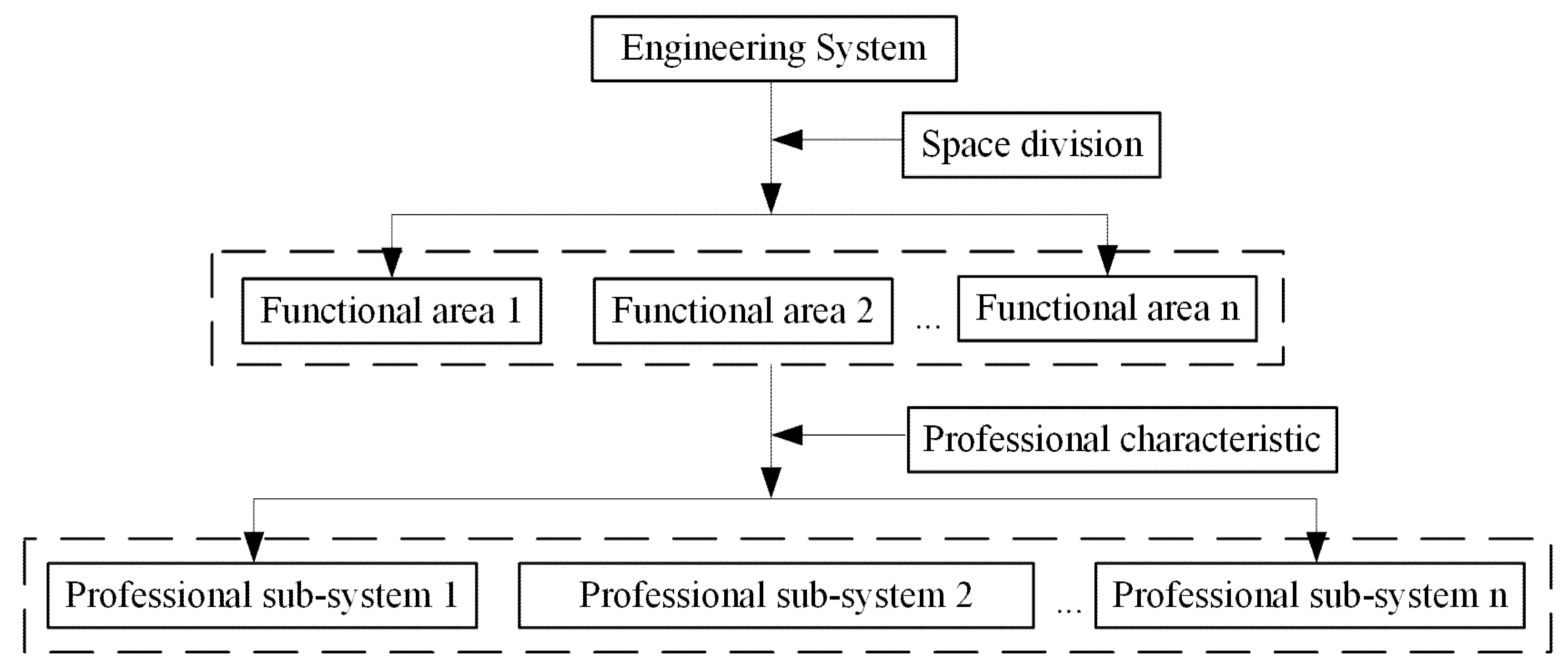
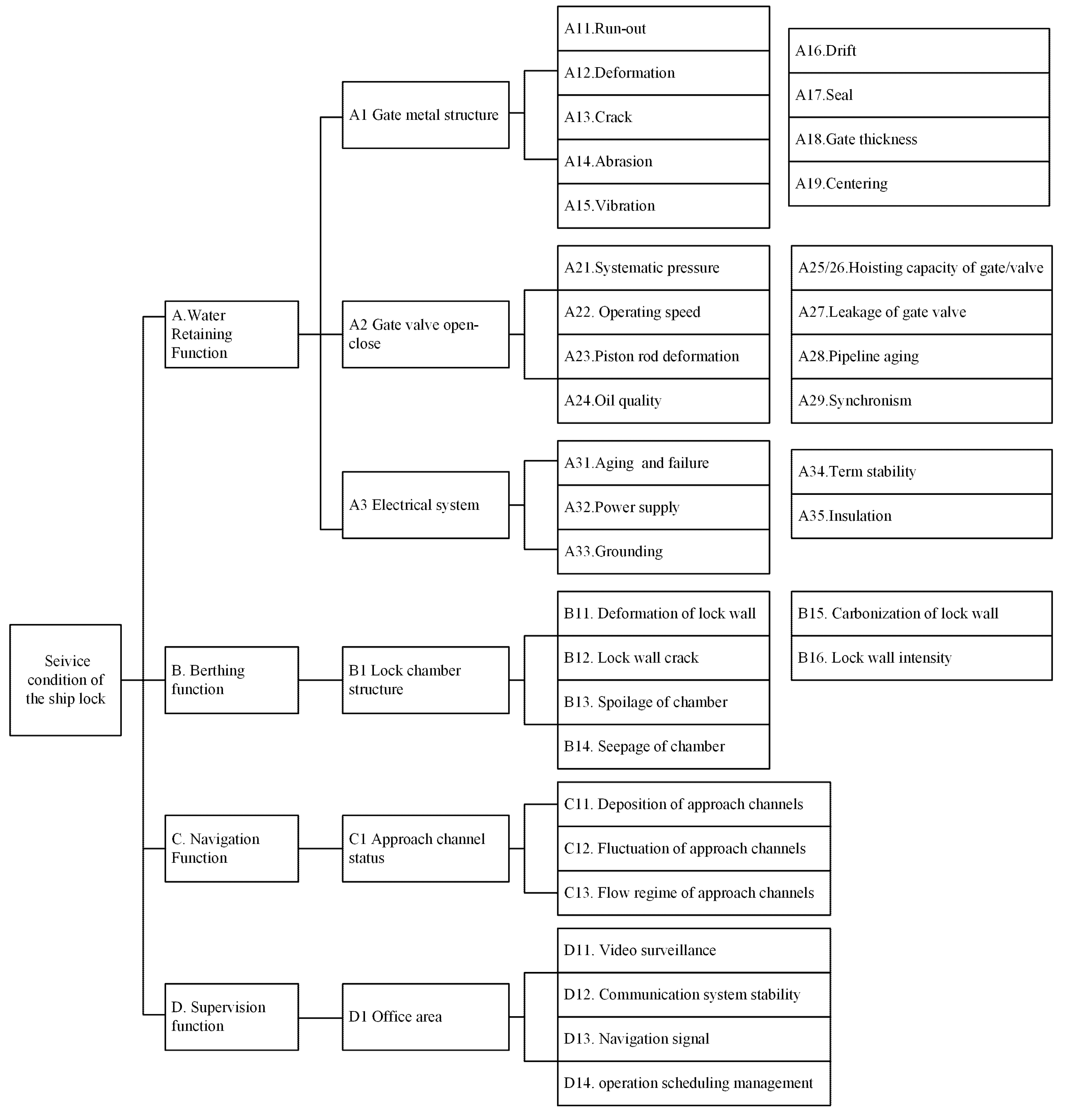
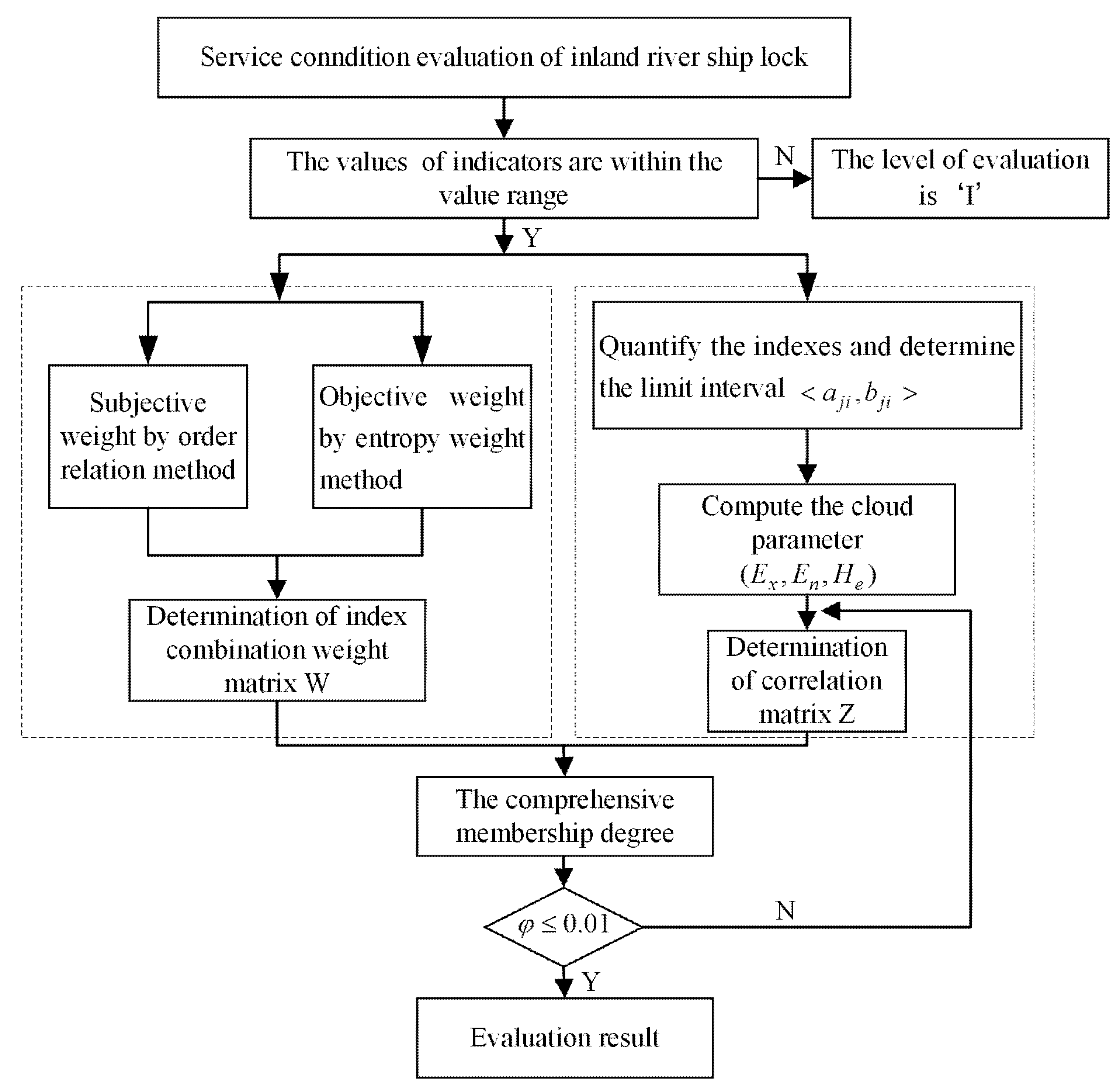


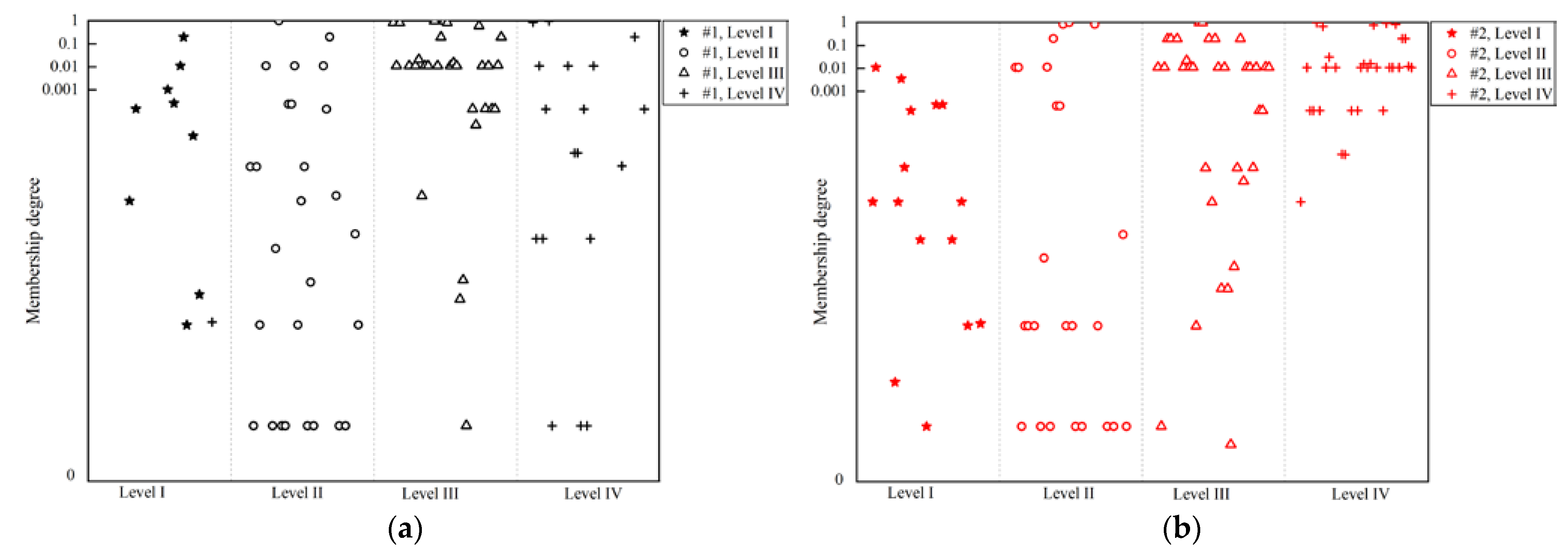
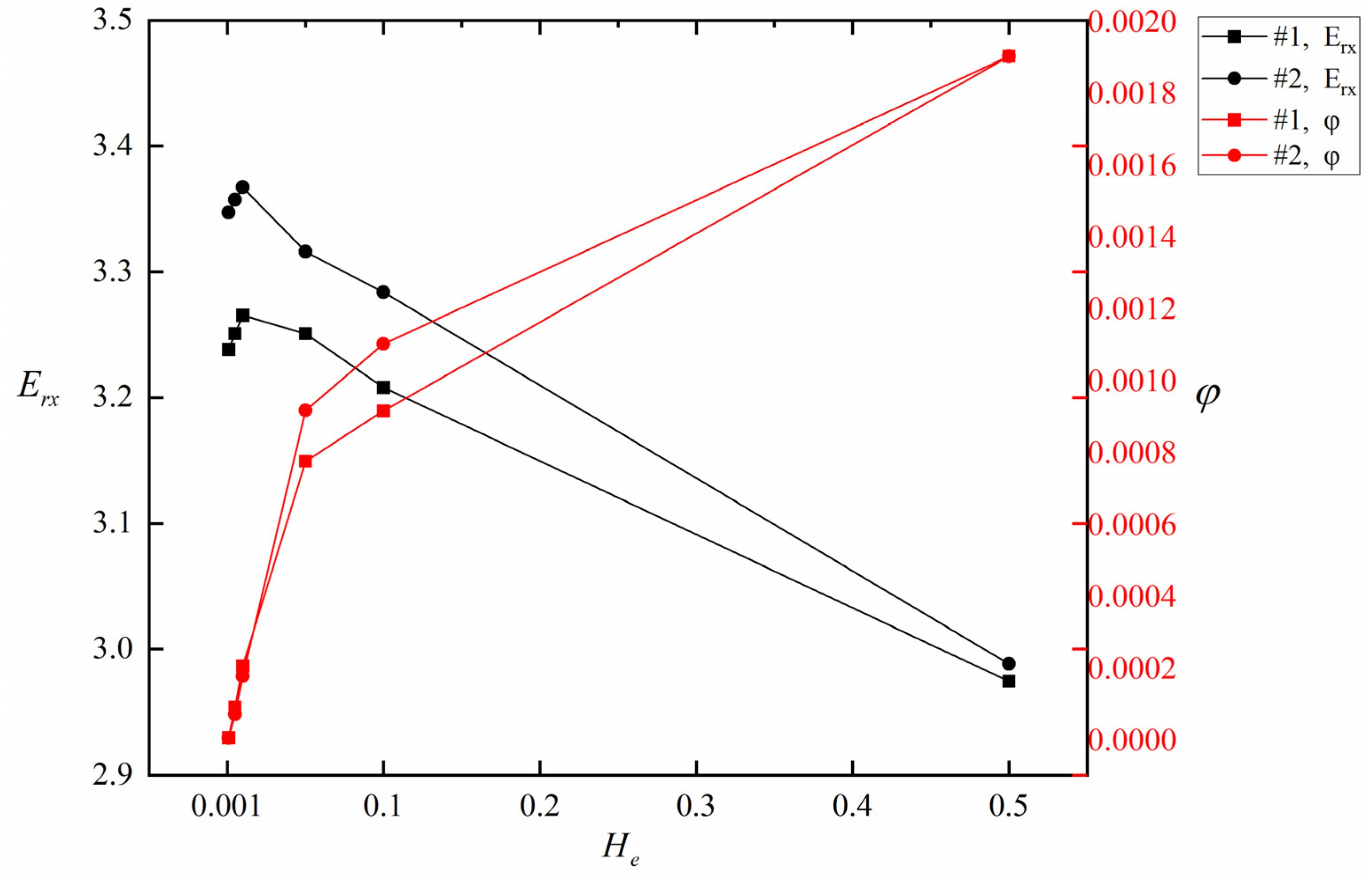
| Level | Definition | Description |
|---|---|---|
| I | Dangerous | Major structural components are unsafety, resulting in the totally failure of the ship lock operation. |
| II | Fatigue | The structure cannot satisfy the requirement of normal serviceability. Some structural components are unsafety, leading to partially endangered building system. |
| III | Sub-health | The structure can generally satisfy the requirement of normal serviceability. Some defects exist in the service condition of ship lock and danger hides. |
| IV | Health | The structure can totally satisfy the requirement of normal serviceability. It is safe and reliable without any serious defects or dangerous indicators. |
| Service Functions | Physical Structures | Characteristics | Unit | |||
|---|---|---|---|---|---|---|
| A. Water Retaining Function | A1. Gate metal structure | A11. Run-out | mm | 0.0135 | 0.0163 | 0.0149 |
| A12. Deformation | Score | 0.0306 | 0.0437 | 0.0371 | ||
| A13. Crack | Score | 0.0202 | 0.0423 | 0.0313 | ||
| A14. Abrasion | Score | 0.0090 | 0.0204 | 0.0147 | ||
| A15. Vibration | Score | 0.0060 | 0.0386 | 0.0223 | ||
| A16. Drift | mm | 0.0040 | 0.0155 | 0.0098 | ||
| A17. Seal | Score | 0.0027 | 0.0360 | 0.0194 | ||
| A18. Gate thickness | mm/mm | 0.0691 | 0.0187 | 0.0439 | ||
| A19. Centering | mm | 0.0456 | 0.0190 | 0.0323 | ||
| A2. Gate valve open-close | A21. Systematic pressure | kN/kN | 0.0301 | 0.0177 | 0.0239 | |
| A22. Operating speed | Unit = 1 | 0.0201 | 0.0170 | 0.0186 | ||
| A23. Piston rod deformation | Score | 0.0452 | 0.0315 | 0.0384 | ||
| A24. Oil quality | Score | 0.0027 | 0.0333 | 0.0180 | ||
| A25. Hoisting capacity of gate | Mpa/Mpa | 0.0136 | 0.0184 | 0.0160 | ||
| A26. Hoisting capacity of valve | Mpa/Mpa | 0.0090 | 0.0393 | 0.0241 | ||
| A27. Leakage of gate valve | Score | 0.0061 | 0.0140 | 0.0100 | ||
| A28. Pipeline aging | Score | 0.0040 | 0.0334 | 0.0187 | ||
| A29. Synchronism | s | 0.0018 | 0.0509 | 0.0264 | ||
| A3. Electrical system | A31. Aging and failure | Score | 0.0335 | 0.0348 | 0.0342 | |
| A32. Power supply | Score | 0.0223 | 0.0211 | 0.0217 | ||
| A33. Grounding | unit = 1 | 0.0101 | 0.0325 | 0.0213 | ||
| A34. Term stability | Score | 0.0149 | 0.0245 | 0.0197 | ||
| A35. Insulation | unit = 1 | 0.0070 | 0.0398 | 0.0234 | ||
| B. Berthing Function | B1. Lock chamber structure | B11. Deformation of lock wall | mm | 0.0658 | 0.0513 | 0.0585 |
| B12. Lock wall rack | unit = 1 | 0.0442 | 0.0375 | 0.0409 | ||
| B13. Spoilage of chamber | Score | 0.0296 | 0.0208 | 0.0252 | ||
| B14. Seepage of chamber | Score | 0.0198 | 0.0187 | 0.0193 | ||
| B15. Carbonization of lock wall | mm | 0.0135 | 0.0330 | 0.0232 | ||
| B16. Lock wall intensity | Mpa/Mpa | 0.0092 | 0.0266 | 0.0179 | ||
| C. Navigation Function | C1. Approach channel status | C11. Deposition of approach channels | Score | 0.1299 | 0.0283 | 0.0791 |
| C12. Fluctuation of approach channels | m | 0.0872 | 0.0150 | 0.0511 | ||
| C13. Flow regime of approach channels | Score | 0.0596 | 0.0352 | 0.0474 | ||
| D. Supervision Function | D1. Office area | D11. Video surveillance | Score | 0.0226 | 0.0172 | 0.0199 |
| D12. Communication system stability | Score | 0.0333 | 0.0151 | 0.0242 | ||
| D13. Navigation signal | unit = 1 | 0.0151 | 0.0175 | 0.0163 | ||
| D14. operation scheduling management | Score | 0.0490 | 0.0251 | 0.0371 |
| Indexes | Value Range | Service Condition Level | |||
|---|---|---|---|---|---|
| I | II | III | IV | ||
| A11. Run-out | [0, 6] | (4, 6] | (3, 4] | (2, 3] | [0, 2] |
| A12. Deformation | [0, 100] | [0, 25) | [25, 50) | [50, 75) | [75, 100] |
| A13. Crack | [0, 100] | [0, 25) | [25, 50) | [50, 75) | [75, 100] |
| A14. Abrasion | [0, 100] | [0, 25) | [25, 50) | [50, 75) | [75, 100] |
| A15. Vibration | [0, 100] | [0, 25) | [25, 50) | [50, 75) | [75, 100] |
| A16. Drift | [0, 300] | (200, 300] | (175, 200] | (150, 175] | [0, 150] |
| A17. Seal | [0, 100] | [0, 25) | [25, 50) | [50, 75) | [75, 100] |
| A18. Gate thickness | [0, 2] | [0, 0.85) | [0.85, 0.9) | [0.9, 0.95) | [0.95, 2] |
| A19. Centering | [0, 60] | (40, 60] | (35, 40] | (30, 35] | [0, 30] |
| A21. Systematic pressure | [0, 1] | (0.075, 1] | (0.05, 0.075] | (0.02, 0.05] | [0, 0.02] |
| A22. Operating speed | [0, 1] | [0, 0.5) | [0.5, 0.7) | [0.7, 0.9) | [0.9, 1] |
| A23. Piston rod deformation | [0, 100] | [0, 25) | [25, 50) | [50, 75) | [75, 100] |
| A24. Oil quality | [0, 100] | [0, 25) | [25, 50) | [50, 75) | [75, 100] |
| A25. Hoisting capacity of gate | [0, 1] | [0, 0.18) | [0.18, 0.62) | [0.62, 0.78) | [0.78, 1] |
| A26. Hoisting capacity of valve | [0, 1] | [0, 0.18) | [0.18, 0.62) | [0.62, 0.78) | [0.78, 1] |
| A27. Leakage of gate valve | [0, 100] | [0, 25) | [25, 50) | [50, 75) | [75, 100] |
| A28. Pipeline aging | [0, 100] | [0, 25) | [25, 50) | [50, 75) | [75, 100] |
| A29. Synchronism | [0, 30] | [25, 30] | [15, 25) | [5, 15) | [0, 5) |
| A31. Aging and failure | [0, 100] | [0, 25) | [25, 50) | [50, 75) | [75, 100] |
| A32. Power supply | [0, 100] | [0, 25) | [25, 50) | [50, 75) | [75, 100] |
| A33. Grounding | [0, 1] | [0, 0.85) | [0.85, 0.9) | [0.9, 0.95) | [0.95, 1] |
| A34. Term stability | [0, 100] | [0, 25) | [25, 50) | [50, 75) | [75, 100] |
| A35. Insulation | [0, 1] | [0, 0.85) | [0.85, 0.9) | [0.9, 0.95) | [0.95, 1] |
| B11. Deformation of lock wall | [0, 15] | (10, 15] | (8, 10] | (5, 8] | [0, 5] |
| B12. Lock wall crack | [0, 10] | (8, 10] | (5, 8] | (2, 5] | [0, 2] |
| B13. Spoilage of chamber | [0, 100] | [0, 25) | [25, 50) | [50, 75) | [75, 100] |
| B14. Seepage of chamber | [0, 100] | [0, 25) | [25, 50) | [50, 75) | [75, 100] |
| B15. Carbonization of lock wall | [0, 20] | [15, 20] | [10, 15) | [5, 10) | [0, 5) |
| B16. Lock wall intensity | [0, 2] | [0, 1) | [1, 1.2) | [1.2, 1.5) | [1.5, 2] |
| C11. Deposition of approach channels | [0, 100] | [0, 25) | [25, 50) | [50, 75) | [75, 100] |
| C12. Fluctuation of approach channels | [0, 3] | (1.5, 3] | (1, 1.5] | (0.5, 1] | [0, 0.5] |
| C13. Flow regime of approach channels | [0, 100] | [0, 25) | [25, 50) | [50, 75) | [75, 100] |
| D11. Video surveillance | [0, 100] | [0, 25) | [25, 50) | [50, 75) | [75, 100] |
| D12. Communication system stability | [0, 100] | [0, 25) | [25, 50) | [50, 75) | [75, 100] |
| D13. navigation signal | [0, 1] | [0, 0.5) | [0.5, 0.75) | [0.75, 0.9) | [0.9, 1] |
| D14. operation scheduling management | [0, 100] | [0, 25) | [25, 50) | [50, 75) | [75, 100] |
| Indexes | Value | Weight | I | II | III | IV |
|---|---|---|---|---|---|---|
| A11. Run-out | 0.815 | 0.0149 | 0.0000 | 0.0000 | 0.0000 | 0.8572 |
| A12. Deformation | 60.000 | 0.0371 | 0.0000 | 0.0000 | 0.8353 | 0.0000 |
| A13. Crack | 75.000 | 0.0313 | 0.0000 | 0.0000 | 0.0111 | 0.0111 |
| A14. Abrasion | 60.000 | 0.0147 | 0.0000 | 0.0000 | 0.8353 | 0.0000 |
| A15. Vibration | 70.000 | 0.0223 | 0.0000 | 0.0000 | 0.1979 | 0.0001 |
| A16. Drift | 80.000 | 0.0098 | 0.0000 | 0.0000 | 0.0000 | 0.9802 |
| A17. Seal | 50.000 | 0.0194 | 0.0000 | 0.0111 | 0.0111 | 0.0000 |
| A18. Gate thickness | 2.000 | 0.0439 | 0.0000 | 0.0000 | 0.0000 | 0.0111 |
| A19. Centering | 30.000 | 0.0323 | 0.0000 | 0.0000 | 0.0111 | 0.0111 |
| A21. Systematic pressure | 0.020 | 0.0239 | 0.0036 | 0.0000 | 0.0209 | 0.0325 |
| A22. Operating speed | 0.600 | 0.0186 | 0.0002 | 1.0000 | 0.0000 | 0.0000 |
| A23. Piston rod deformation | 75.000 | 0.0384 | 0.0000 | 0.0000 | 0.0111 | 0.0111 |
| A24. Oil quality | 75.000 | 0.0180 | 0.0000 | 0.0000 | 0.0111 | 0.0111 |
| A25. Hoisting capacity of gate | 0.700 | 0.0160 | 0.0000 | 0.0002 | 1.0000 | 0.0000 |
| A26. Hoisting capacity of valve | 0.700 | 0.0241 | 0.0000 | 0.0002 | 1.0000 | 0.0000 |
| A27. Leakage of gate valve | 50.000 | 0.0100 | 0.0000 | 0.0111 | 0.0111 | 0.0000 |
| A28. Pipeline aging | 70.000 | 0.0187 | 0.0000 | 0.0000 | 0.1979 | 0.0001 |
| A29. Synchronism | 10.000 | 0.0264 | 0.0000 | 0.0000 | 1.0000 | 0.0000 |
| A31. Aging and failure | 60.000 | 0.0342 | 0.0000 | 0.0000 | 0.8353 | 0.0000 |
| A32.Power supply | 75.000 | 0.0217 | 0.0000 | 0.0000 | 0.0111 | 0.0111 |
| A33. Grounding | 0.950 | 0.0213 | 0.0010 | 0.0000 | 0.0148 | 0.0151 |
| A34. Term stability | 75.000 | 0.0197 | 0.0000 | 0.0000 | 0.0111 | 0.0111 |
| A35. Insulation | 1.000 | 0.0234 | 0.0003 | 0.0000 | 0.0000 | 0.0152 |
| B11. Deformation of lock wall | 2.900 | 0.0585 | 0.0000 | 0.0000 | 0.0000 | 0.8912 |
| B12. Lock wall crack | 8.000 | 0.0409 | 0.0111 | 0.0111 | 0.0000 | 0.0000 |
| B13. Spoilage of chamber | 20.000 | 0.0252 | 0.1979 | 0.0001 | 0.0000 | 0.0000 |
| B14. Seepage of chamber | 45.000 | 0.0193 | 0.0000 | 0.1979 | 0.0001 | 0.0000 |
| B15. Carbonization of lock wall | 3.700 | 0.0232 | 0.0000 | 0.0000 | 0.0000 | 0.3545 |
| B16. Lock wall intensity | 1.300 | 0.0179 | 0.0000 | 0.0000 | 0.6062 | 0.0000 |
| C11. Deposition of approach channels | 75.000 | 0.0791 | 0.0000 | 0.0000 | 0.0111 | 0.0111 |
| C12. Fluctuation of approach channels | 0.400 | 0.0511 | 0.0000 | 0.0000 | 0.0002 | 0.1976 |
| C13. Flow regime of approach channels | 75.000 | 0.0474 | 0.0000 | 0.0000 | 0.0111 | 0.0111 |
| D11. Video surveillance | 80.000 | 0.0199 | 0.0000 | 0.0000 | 0.0001 | 0.1979 |
| D12. Communication system stability | 80.000 | 0.0242 | 0.0000 | 0.0000 | 0.0001 | 0.1979 |
| D13. navigation signal | 0.900 | 0.0163 | 0.0000 | 0.0000 | 0.0117 | 0.0118 |
| D14. operation scheduling management | 70.000 | 0.0371 | 0.0000 | 0.0000 | 0.1979 | 0.0001 |
| Indexes | Value | Weight | I | II | III | IV |
|---|---|---|---|---|---|---|
| A11. Run-out | 3.000 | 0.0149 | 0.0000 | 0.0111 | 0.0111 | 0.0000 |
| A12. Deformation | 25.000 | 0.0371 | 0.0111 | 0.0111 | 0.0000 | 0.0000 |
| A13. Crack | 75.000 | 0.0313 | 0.0000 | 0.0000 | 0.0111 | 0.0111 |
| A14. Abrasion | 70.000 | 0.0147 | 0.0000 | 0.0000 | 0.1979 | 0.0001 |
| A15. Vibration | 70.000 | 0.0223 | 0.0000 | 0.0000 | 0.1979 | 0.0001 |
| A16. Drift | 80.000 | 0.0098 | 0.0000 | 0.0000 | 0.0000 | 0.9802 |
| A17. Seal | 70.000 | 0.0194 | 0.0000 | 0.0000 | 0.1979 | 0.0001 |
| A18. Gate thickness | 1.630 | 0.0439 | 0.0000 | 0.0000 | 0.0000 | 0.6754 |
| A19. Centering | 30.000 | 0.0323 | 0.0000 | 0.0000 | 0.0111 | 0.0111 |
| A21. Systematic pressure | 0.020 | 0.0239 | 0.0036 | 0.0000 | 0.0219 | 0.0315 |
| A22. Operating speed | 0.700 | 0.0186 | 0.0000 | 0.0114 | 0.0113 | 0.0000 |
| A23. Piston rod deformation | 75.000 | 0.0384 | 0.0000 | 0.0000 | 0.0111 | 0.0111 |
| A24. Oil quality | 30.000 | 0.0180 | 0.0001 | 0.1979 | 0.0000 | 0.0000 |
| A25. Hoisting capacity of gate | 0.700 | 0.0160 | 0.0000 | 0.0002 | 1.0000 | 0.0000 |
| A26. Hoisting capacity of valve | 0.700 | 0.0241 | 0.0000 | 0.0002 | 1.0000 | 0.0000 |
| A27. Leakage of gate valve | 40.000 | 0.0100 | 0.0000 | 0.8353 | 0.0000 | 0.0000 |
| A28. Pipeline aging | 70.000 | 0.0187 | 0.0000 | 0.0000 | 0.1979 | 0.0001 |
| A29. Synchronism | 20.000 | 0.0264 | 0.0000 | 1.0000 | 0.0000 | 0.0000 |
| A31. Aging and failure | 70.000 | 0.0342 | 0.0000 | 0.0000 | 0.1979 | 0.0001 |
| A32. Power supply | 75.000 | 0.0217 | 0.0000 | 0.0000 | 0.0111 | 0.0111 |
| A33. Grounding | 1.000 | 0.0213 | 0.0003 | 0.0000 | 0.0000 | 0.0155 |
| A34. Term stability | 75.000 | 0.0197 | 0.0000 | 0.0000 | 0.0111 | 0.0111 |
| A35. Insulation | 1.000 | 0.0234 | 0.0003 | 0.0000 | 0.0000 | 0.0158 |
| B11. Deformation of lock wall | 1.900 | 0.0585 | 0.0000 | 0.0000 | 0.0000 | 0.7717 |
| B12. Lock wall crack | 0.000 | 0.0409 | 0.0000 | 0.0000 | 0.0000 | 0.0111 |
| B13. Spoilage of chamber | 40.000 | 0.0252 | 0.0000 | 0.8353 | 0.0000 | 0.0000 |
| B14. Seepage of chamber | 70.000 | 0.0193 | 0.0000 | 0.0000 | 0.1979 | 0.0001 |
| B15. Carbonization of lock wall | 2.800 | 0.0232 | 0.0000 | 0.0000 | 0.0000 | 0.9373 |
| B16. Lock wall intensity | 1.500 | 0.0179 | 0.0000 | 0.0000 | 0.0111 | 0.0111 |
| C11. Deposition of approach channels | 75.000 | 0.0791 | 0.0000 | 0.0000 | 0.0111 | 0.0111 |
| C12. Fluctuation of approach channels | 0.300 | 0.0511 | 0.0000 | 0.0000 | 0.0000 | 0.8352 |
| C13. Flow regime of approach channels | 75.000 | 0.0474 | 0.0000 | 0.0000 | 0.0111 | 0.0111 |
| D11. Video surveillance | 80.000 | 0.0199 | 0.0000 | 0.0000 | 0.0001 | 0.1979 |
| D12. Communication system stability | 80.000 | 0.0242 | 0.0000 | 0.0000 | 0.0001 | 0.1979 |
| D13. navigation signal | 0.900 | 0.0163 | 0.0000 | 0.0000 | 0.0116 | 0.0122 |
| D14. operation scheduling management | 75.000 | 0.0371 | 0.0000 | 0.0000 | 0.0111 | 0.0111 |
Disclaimer/Publisher’s Note: The statements, opinions and data contained in all publications are solely those of the individual author(s) and contributor(s) and not of MDPI and/or the editor(s). MDPI and/or the editor(s) disclaim responsibility for any injury to people or property resulting from any ideas, methods, instructions or products referred to in the content. |
© 2023 by the authors. Licensee MDPI, Basel, Switzerland. This article is an open access article distributed under the terms and conditions of the Creative Commons Attribution (CC BY) license (https://creativecommons.org/licenses/by/4.0/).
Share and Cite
Zhang, N.; Xu, S.; Mao, L.; Guo, M.; Tang, S.; Yin, K. Fuzzy Evaluation of Inland Ship Lock Service Condition Based on Combination Weighting and Matter-Element Extension Cloud Model. J. Mar. Sci. Eng. 2023, 11, 757. https://doi.org/10.3390/jmse11040757
Zhang N, Xu S, Mao L, Guo M, Tang S, Yin K. Fuzzy Evaluation of Inland Ship Lock Service Condition Based on Combination Weighting and Matter-Element Extension Cloud Model. Journal of Marine Science and Engineering. 2023; 11(4):757. https://doi.org/10.3390/jmse11040757
Chicago/Turabian StyleZhang, Nini, Sudong Xu, Liuyan Mao, Meiting Guo, Shuang Tang, and Kai Yin. 2023. "Fuzzy Evaluation of Inland Ship Lock Service Condition Based on Combination Weighting and Matter-Element Extension Cloud Model" Journal of Marine Science and Engineering 11, no. 4: 757. https://doi.org/10.3390/jmse11040757
APA StyleZhang, N., Xu, S., Mao, L., Guo, M., Tang, S., & Yin, K. (2023). Fuzzy Evaluation of Inland Ship Lock Service Condition Based on Combination Weighting and Matter-Element Extension Cloud Model. Journal of Marine Science and Engineering, 11(4), 757. https://doi.org/10.3390/jmse11040757







